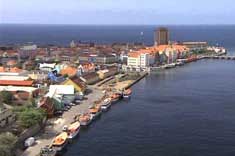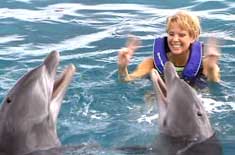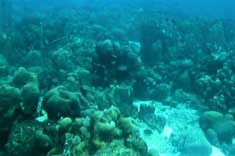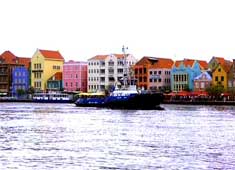Curaçao
 Where can you go in the Netherlands that’s not in Europe? It’s the island of Curaçao. The largest of the ABC islands (Aruba, Bonaire are the other two) in the Caribbean, Curaçao, is just off the coast of Venezuela. Its name is derived from a Portuguese word for heart, since it was at the center of trade routes and fought over by most countries of Europe. The Dutch won out, and this isle is a self governing possession of the Netherlands. Kind of like what Puerto Rico is to the United States! Called Dutch or Netherlands Antilles, it is truly a tropical paradise, though it has a little more European flavor than the other surrounding islands, and the culture is definitely a great mix.
Where can you go in the Netherlands that’s not in Europe? It’s the island of Curaçao. The largest of the ABC islands (Aruba, Bonaire are the other two) in the Caribbean, Curaçao, is just off the coast of Venezuela. Its name is derived from a Portuguese word for heart, since it was at the center of trade routes and fought over by most countries of Europe. The Dutch won out, and this isle is a self governing possession of the Netherlands. Kind of like what Puerto Rico is to the United States! Called Dutch or Netherlands Antilles, it is truly a tropical paradise, though it has a little more European flavor than the other surrounding islands, and the culture is definitely a great mix.
During the early years, many cultures came and went on the island, including the Arawak, the Dutch, the Spanish, the West Indians, Latins, and Africans. Now add in the buccaneers and pirates, and you’ve got quite a colorful mix! The reason they all fought over this little island was because of the naturally deep harbor. The biggest ships in the world can get in here. In fact, the Queen Juliana Bridge was built really high so the ships could come in, bringing all the cruise ship passengers right into town, making a great economy.
Willemstad, the capital of Curaçao, is divided by St. Anna’s Bay in to two sections. These sections are connected by a bridge. But not just any old bridge…a pontoon bridge! It’s the oldest pontoon bridge in the Caribbean, resting on little flat boats. I can’t compare it to anything, as it is the only pontoon bridge I’ve ever seen in my life!
Back in the old days, it used to cost two cents to cross the bridge. But it was free if you were barefoot. So you’d see all the rich people coming down, taking off their expensive shoes, and carrying them across the bridge to save money. Today, you can walk across for free and wear your shoes. One side of the river is called Punda, which literally means “point.” Locals just call it “this side”. The opposite bank is called Otrabanda, which means, “the other side!” Hmm- “this side… and the other side!” Sure keeps it simple!
Most of the sights are so close together, taking a walking tour is one of the best ways to see the highlights. The oldest synagogue in the western hemisphere is a main draw for visitors. Featuring Dutch Colonial architecture, the Mikve Israel-Emanuel Synagogue still covers the floor with sand to represent the deserts braved by the ancient Israelites. You know, even though it looks like it, this isn’t a movie set or a theme park. The buildings here really do date back to the 16 and 1700s. Dutch colonial architecture is what gives Willemstad its signature. These picturesque buildings are still in use today. In fact, one of the oldest is Fort Amsterdam, still the seat of government of the Dutch Antilles.
Some of the little side streets look almost exactly like they did in the 1700’s. In fact, I just discovered that Willemstad is on the UNESCO World Heritage list. Now that’s impressive! It’s hard to get lost in Willemstad…streets are laid out on a grid, and if in doubt, just head towards the water. That’s where you’ll find one of the city’s more colorful attractions, the floating market. Yep…here’s where your “catch of the day” arrives fresh every morning!
It’s kind of ironic that Willemstad became a big trading port in the 18th century, because trading and selling goods here is still a big draw. Today, we call it “shopping” and duty-free is the key! Well, technically, it’s “duty-light” as the shopkeepers pay a small duty, but there’s no sales tax, so you should be able to get some fairly good deals on, jewelry, clothing and electronics. And where to shop is easy…the main shopping street is named the same on both sides of the river…”Breedestraat”. I told you they keep it simple!
As you’re walking around getting deals on cigars and watches, look up, you’ll see the castle on the hill above the river. That’s Fort Nassau! Finished in 1797, its massive stone walls once protected this side of the island from invaders. Today, the soldiers are gone, but it’s still a big draw for visitors….at night! There are great spots for eating dinner, and yes, the catch of the day is what you saw coming off the boats this morning in the harbor.
 If you plan on visiting Curaçao it’s best to be comfortable in the water because a sea of learning opportunities await! But the best students aren’t necessarily human! Founded in May 2002, the Dolphin Academy Curaçao has added two legged pupils to the roster…and there’s only one goal…To teach people about dolphins and to share the excitement of interacting with these wonderful animals. And students…you’re gonna get wet!
If you plan on visiting Curaçao it’s best to be comfortable in the water because a sea of learning opportunities await! But the best students aren’t necessarily human! Founded in May 2002, the Dolphin Academy Curaçao has added two legged pupils to the roster…and there’s only one goal…To teach people about dolphins and to share the excitement of interacting with these wonderful animals. And students…you’re gonna get wet!
A dolphin swim is actually a very intimate program. While you go swimming–you got fins, you go swimming–the dolphin actually chooses to be with you. They’ll come swimming alongside you, so you can gently pet them and stroke them. And, what you really have is the interaction, ’cause you and the dolphin now have a bond. All the interaction with the dolphins takes place in small groups and the result is a one-of-a kind one-on-one experience. My daughter, Elizabeth, and I got in the water and were instructed to tap the surface of the water with the palms of our hands. The dolphins come up and you pat them, so they can feel your hands. That was so cool. I never thought I’d high-five a dolphin! Teresa decided to be my dolphin of the day. Hey! “no splashing” is pool rule #3. You definitely can’t do this everywhere!
While this is definitely a performance, one of the Dolphin Academy’s main objectives is to study, protect and train these amazing animals. And swimming with visitors is sort of like “dolphin final exams”! When we were there, they had eight dolphins, two of which were babies. One was five months old, named Chabanita, and, another one was a year and a half, named Nina. Both of her parents are there and there was one big male named Copa. Ok…I’m in love. Dolphins are definitely intelligent… but are there any other animals this smart? They are more intelligent than most other animals because they have their own language, which is how they use their sounds, it’s them talking to each other. What a great family outing ! SO be sure and put this on your list of things to do.
You know, Curaçao has to be one the Caribbean’s most interesting islands, with amazing beaches, beautiful landscapes…but its beauty isn’t just limited to its natural wonders. As it turns out, the people of Curaçao are the island’s greatest treasures. The locals here all speak at least four or five languages…English, Dutch, French, Spanish, and the local blend, called Papiamento, a Creole mix of African dialects, Portuguese, Spanish and Dutch. One of the more colorful locals here is also a healer, whose medicine of choice is plants. Since the early 80’s she’s become a one-woman crusader to preserve this kind of natural medicine. One of her dreams came true when she began Den Paradera. Today, this botanical garden is home to over 300 species of wild medicinal plants. This is where you can find all kind of local herbs and listen to all the stories of how people lived on this island. You can see the shop, with its local herbs, pomades, shampoos, all kind of oils and salves and souvenirs of Curaçao. And she actually does medicinal consultations right there in the garden! Most of her treatments were learned from her mother using only local plants & herbs. She makes a nasty concoction that really empties your stomach and cleans out your system when you drink it. Needless, to say, I declined her offer of a free sample!
If there’s one thing Curaçao has, it’s lots of water sports. So I figure another dip into the Caribbean won’t hurt! But, what to choose? Eenie, meenie, miney mo…let’s do ‘em all…come on! Let’s go! The water here is incredibly clear, so a good choice is snorkeling and they have everything you need right there, though they do suggest you bring a swimsuit. You just go out and jump in! You can expect to see down between 80 and 120 feet. Now don’t worry, if you can swim, you can snorkel…did I mention this is great for the entire family?
 Sure you could buy a piece of coral in the local souvenir shop but nothing compares with seeing it up close in its natural habitat. Just dive right down, then enjoy the view. Well, at least until your air gives out. Don’t forget the waterproof camera, under water is a great place to take a few pictures of the family—of fish that is! Snorkeling is one of the best activities on the island! What a great time for all.
Sure you could buy a piece of coral in the local souvenir shop but nothing compares with seeing it up close in its natural habitat. Just dive right down, then enjoy the view. Well, at least until your air gives out. Don’t forget the waterproof camera, under water is a great place to take a few pictures of the family—of fish that is! Snorkeling is one of the best activities on the island! What a great time for all.
Curaçao’s lifestyle may be laid back and relaxed, but there’s one thing that spices things up around here…the food! Seafood, of course, is popular, but there’s more than meets the eye. Mix a few of the African and Indian spices with some of the local ingredients…add in a little family tradition… and you’ve got flavor. Not spicy hot…just good.
Now, for the after dinner chaser, what would be good? Craçao’s also famous for the liqueur of the same name. Apparently, in 1499, the Spanish brought Valencia oranges here to the island, thinking they would grow. Well, instead of growing sweet, the soil here made them, they say, so bitter, even the island goats wouldn’t eat them. Well, years later, one of the families here started experimenting with the oils of the orange, by mixing them with some of the spices here. Low and behold, the liqueur was born. Every bottle has a label with that little Valencia orange on it, and it tastes the way the Spanish wanted the orange to taste in the first place.
Now I bet you thought that all you could do in Curaçao is to enjoy the water, relax, eat, drink, just enjoy taking it easy. BEEP! There is more to do and see! There’s even an ostrich farm where visitors can get a close-up look at these fascinating birds, and they can get a good look at you. You can touch them, feed them photograph them, and if you’re a real daredevil, you can ride them!
At the Curaçao Ostrich Farm, you head out to explore the area and see these wild birds in a safari truck. Every hour, safari tours are driven through the farm corrals where the ostriches live. Here, you’ll see the emu, the Australian ostrich. The difference between Australian and the South African ostriches they also have is easy. They’ve got a black neck with some blue on both sides. Emus are much more aggressive than the South African variety, because when they kick, they are also pecking your eyes out at the same time. They are mean. When we visited, all the ostriches were 17 years old. The farm started with 150 males and 100 females, the ones with the gray feathers. The breeding season is from February to August. During the season, each female can lay 60, up to 80 eggs. And if you’ve never seen an ostrich egg…they’re almost as big as my head. Now that is one big omelet ! Visiting the farm can be a little side trip in between eating, snorkeling, eating, diving, eating and drinking in Curaçao.
 There’s so much to enjoy here, the history, the island people. And, while most visitors just get a quick one day look on a cruise, it’s definitely a great place to come back to! The water is so clear here, you’ll be able to see wonderful sea-life everywhere. Do watch out for pirates, you never know when Jack Sparrow might come swaggering through for curaçao liqueur when he runs out of rum.
There’s so much to enjoy here, the history, the island people. And, while most visitors just get a quick one day look on a cruise, it’s definitely a great place to come back to! The water is so clear here, you’ll be able to see wonderful sea-life everywhere. Do watch out for pirates, you never know when Jack Sparrow might come swaggering through for curaçao liqueur when he runs out of rum.
